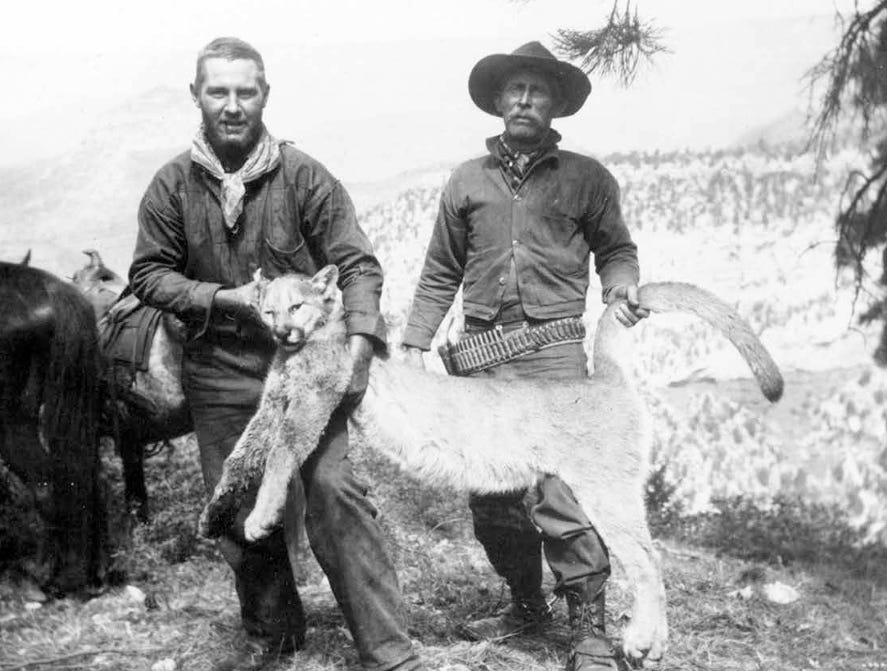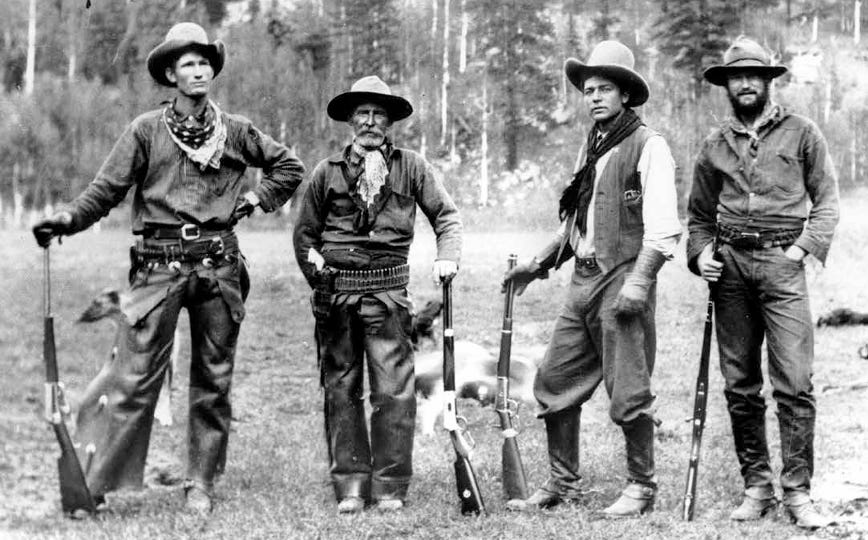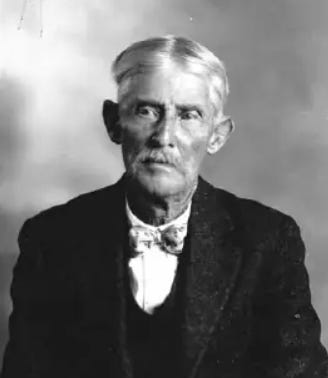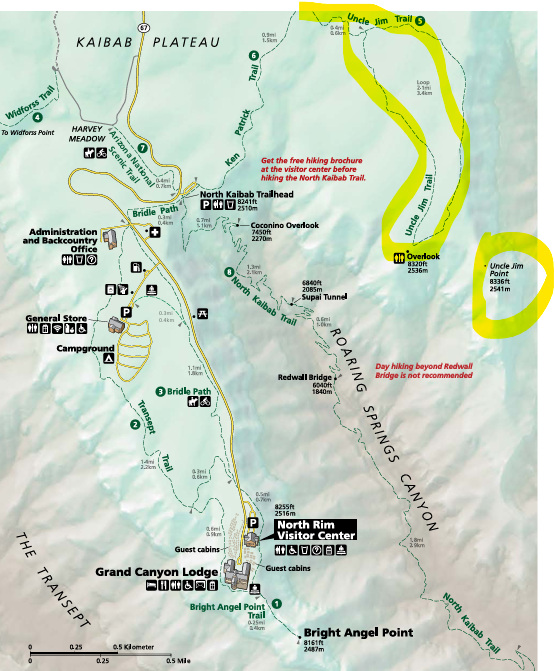"Uncle" Jimmy Owens of the Grand Canyon
Lion hunter that caused an overpopulation of deer at the North Rim
In 1906, James "Uncle Jimmy" Owens, at the request of Teddy Roosevelt, moved to the remote North Rim of the Grand Canyon to help control the mountain lion population and caused an overpopulation of deer in the process. He was a quiet, but yet very important figure in the making of the west and Grand Canyon National Park.

James T. Owens was born near San Antonio, Texas, probably in the late 1840s. Jimmy’s father died when he was a young boy. After his mother remarried, his stepfather did not treat him well so at the age of eleven Jimmy ran away from home to work on various Texas ranches and cattle drives. That began 45-year career on the trail as cowboy and frontiersman.
He was a gentle and kind-hearted man, a lifelong bachelor who loved kids, which earned him the affectionate nickname "Uncle."
Buffalo Warden in Yellowstone
Owens was hired as Yellowstone’s buffalo keeper in 1904 for seventy-five dollars per month. He not only became responsible for buffalo but also all wildlife in Yellowstone.
President Theodore Roosevelt visited the Grand Canyon in 1903. An avid outdoorsman and staunch conservationist, he established the Grand Canyon Game Preserve on November 28, 1906. Owens stayed on at Yellowstone until April 1906 when, at the request of President Roosevelt, he became Arizona’s first game warden on the newly created preserve.
Game Warden at Grand Canyon Game Preserve
In 1907, Uncle Jim became the first game warden for the forest reserve where his mission was predator control – to hunt and trap cougars and wolves in order to protect the mule deer on the North Rim. He held that post until the establishment of Grand Canyon National Park in 1919.

Cougars, aka mountain lions, are large cats that occur throughout the western United States and are common throughout the Southwest. Males measure five to nine feet from head to tail and weigh 150 to 200 pounds. Females are smaller weighing 80 to 130 pounds and averaging five to seven feet in length. They hunt some smaller animals such as skunks, porcupines and rabbits however their primary prey are deer. They are agile and fast while running short distances to catch prey but cannot run fast for long distances which is why hunters such as Owens could catch them with a pack of hounds. He had a large pack of hounds that he used to tree the mountain lions for the kill.

In addition to job as game warden, Owens was hired by cattlemen to hunt the mountain lions that were killing cattle. There were so many that at times he would earn up to $500 a day in bounties.

Killing Predator Species Had Dire Consequences
It is estimated that Uncle Jim eliminated over 600 mountain lions between 1907 and 1919 as part of the preserve's wildlife management strategy. Removing this predator from the ecosystem had serious consequences.
The deer population saw a dramatic increase from roughly 4,000 in 1906 to approximately 100,000 by 1924. This surge in numbers resulted in extensive overgrazing, which impacted not only the deer but also livestock. The landscape reflected this with all accessible vegetation experiencing defoliation. The repercussions of this overpopulation hindered the foliage regeneration for more than a decade.
In the harsh winter of 1924-1925, more than half of the deer population died of starvation.
Jim Owens Met Many Famous People in His Lifetime
In his cowboy days, Jim encountered many legends of the Old West, such as Sheriff Pat Garrett, mountain man Kit Carson, the showman "Buffalo" Bill Cody, Arizona's territorial historian Sharlot Hall, and the famed outlaw Henry McCarty, better known as Billy the Kid, along with some associates of the infamous Jesse James gang.
As I mentioned in my last blog post, in the summer of 1913, Theodore Roosevelt, along with his two sons, embarked on a mountain lion hunting expedition in the Kaibab Forest. They were guided by none other than Uncle Jim Owens.
It is said that the hunting party ate off the land and that the former president found mountain lion meat to be just as tasty as venison.

Somewhere along the line, Uncle Jim must have met up with famed artist of the American Old West, Charles M. Russell. In 1905, the artist painted a watercolor of him and his hunting hounds. In my research, I found that this watercolor was recently up for auction at Sotheby’s. The auction closed this last month (September 2024) and sold for $60,000.
His Last Days
In 1927, Uncle Jim returned to the Texas Panhandle after a 25-year absence. He was then relocated to New Mexico late in December 1929 by one of his “nephews” so he could be taken care of in his final years.
He lived out the rest of his life in the Land of Enchantment and is buried in the Masonic Cemetary in Las Cruces, New Mexico. It’s too bad that he had been taken away from the area he loved. The North Rim of the Grand Canyon was still bears his memory.
How to Visit
In 1932, the National Geographic Board honored Uncle Jimmy Owens by renaming Natchi Point, situated above Roaring Springs, to Uncle Jim Point.
The viewpoint can be accessed via a 5-mile loop trail, which shares its name and starts at the roadside parking area designated for the North Kaibab Trail. This area is located on the North Rim Parkway, two miles before the Grand Canyon Lodge. Due to its popularity among hikers, the parking lot often reaches capacity by mid-morning during peak summer days.
Next Time
A bison herd that was established by Jim Owens has grown too large for the North Rim of the Grand Canyon. How did these bison get there? What did they do with the “extra” bison? Next post will cover the current events of the bison herd that has made the North Rim their home for over a century.









Excellent article, Jan. It shows that there exists a delicate balance in Nature.
This was so interesting, and a really great example of how nature’s food web can be disrupted. I will remember this article to show my kids next time this subject comes up. Thank you so much.